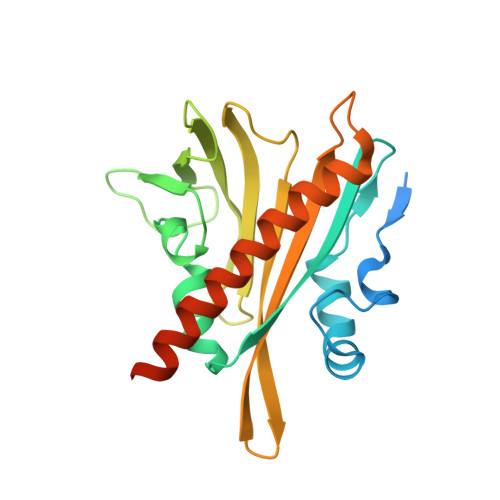Structure-Based Modulation of the Ligand Sensitivity of a Tomato Dimeric Abscisic Acid Receptor Through a Glu to Asp Mutation in the Latch Loop.
Infantes, L., Rivera-Moreno, M., Daniel-Mozo, M., Benavente, J.L., Ocana-Cuesta, J., Coego, A., Lozano-Juste, J., Rodriguez, P.L., Albert, A.(2022) Front Plant Sci 13: 884029-884029
- PubMed: 35734246
- DOI: https://doi.org/10.3389/fpls.2022.884029
- Primary Citation of Related Structures:
7Z1P, 7Z1Q, 7Z1R, 7Z1S - PubMed Abstract:
The binding of the plant phytohormone Abscisic acid (ABA) to the family of ABA receptors (PYR/PYL/RCAR) triggers plant responses to abiotic stress. Thus, the implementation of genetic or chemical strategies to modulate PYR/PYL activity might be biotechnologically relevant. We have employed the available structural information on the PYR/PYL receptors to design SlPYL1, a tomato receptor, harboring a single point mutation that displays enhanced ABA dependent and independent activity. Interestingly, crystallographic studies show that this mutation is not directly involved in ABA recognition or in the downstream phosphatase (PP2C) inhibitory interaction, rather, molecular dynamic based ensemble refinement restrained by crystallographic data indicates that it enhances the conformational variability required for receptor activation and it is involved in the stabilization of an active form of the receptor. Moreover, structural studies on this receptor have led to the identification of niacin as an ABA antagonist molecule in vivo . We have found that niacin blocks the ABA binding site by mimicking ABA receptor interactions, and the niacin interaction inhibits the biochemical activity of the receptor.
Organizational Affiliation:
Instituto de Qu¨ªmica F¨ªsica Rocasolano, Consejo Superior de Investigaciones Cient¨ªficas, Madrid, Spain.



















